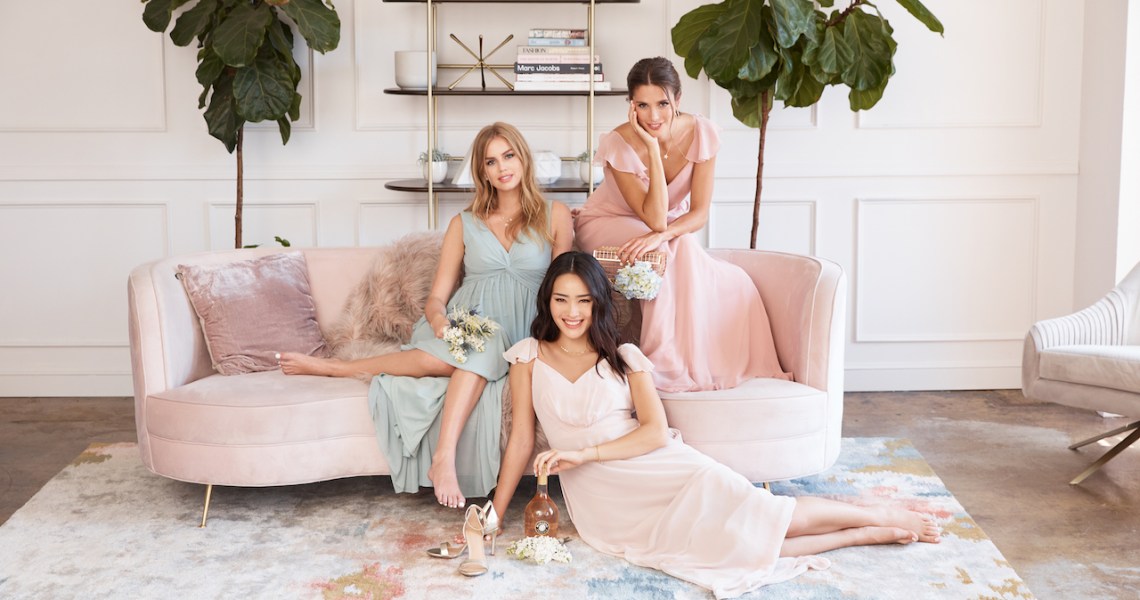DTC bridesmaid dress brand Birdy Grey is focusing on its organic, unpaid Instagram strategy to build new products and sell more $99 dresses.
As the cost to digitally acquire customers is on the rise, a renewed focus on unpaid efforts has been a big sales driver for Birdy Grey — in 2018 the company capped social spend at about $4 per bride and has dressed over 100,000 bridesmaids. While there is a performance marketing team to handle paid social media ads, co-founder Grace Lee handles most of the company’s organic posts on Instagram — something that takes up about 20% of her time, she said. The brand has just 12 employees, all women.
One of the biggest tools for Lee to drive sales and learn more about the customer is the Polls feature in Instagram Stories. The organic strategy has helped the company develop new dresses and colors, as well as launch into new categories like men’s accessories and party decor.
There’s no real schedule as to how often Lee posts polls to Instagram, but she typically keeps it to five to 10 slides: “Beyond that there is a high attrition rate,” she said. Typically, the brand sees about a 2% engagement rate for polls on Instagram.
In spring 2018, the brand posted one of its first polls to figure out what shade of “dusty blue” followers liked most. In the month prior, Lee said she received emails, direct messages and comments that customers wanted to buy bridesmaids dresses in this color. Thus, she posted two different shades on Birdy Grey’s Instagram and within 24 hours found the preferred shade to design.
From there, the company started to test a select number of dress styles in that shade and rolled out a select number of styles in November. While Birdy Grey currently sells 15 styles of dresses, Lee said the team does not ever roll a new color out to all styles right away. Typically, the team tests the color with two or three styles before going all in. In just one year, the dusty blue color has become one of the top-selling colors for Birdy Grey. The company has only launched another color, sage, from poll results in January, but five more are to come.
Earlier this year, Lee pushed out another set of polls to the company’s 56,600 followers focused on gaps in the Birdy Grey color selection. Thanks to data gathered from the brand’s most recent Instagram poll, Birdy Grey is developing the next set of colors for summer, but declined to share specifics.
“Polls are probably our biggest tool to inform product development and design,” Lee said. “The customer feedback loop is everything. We’ve tested Survey Monkey polls, but Instagram polls are the most immediate ways to get feedback.”
Beyond just posting color swatches to figure out what colors customers want to buy, Lee said she tries to think of more creative ways to conduct field research.
“We weren’t sure if we should roll out gifts, and if so what type of gifts, so instead of just putting up a bunch of gifts we are thinking about launching, we asked what gifts bridesmaids pay for [such shower gifts, ring boxes, bachelorette party decorations] in a poll format. It felt a little bit more organic that way,” Lee said.
While organic is a big part of the company’s push on Instagram, paid marketing is still part of the equation. In 2018, when the brand was just a year old, the performance marketing team started spending $10 a day on Instagram, which drove $2 million in revenue in 2018. Now the daily spend is closer to $35.
“A lot of brands will focus on Instagram as just an acquisition tool, promoting a single product and a single message. The most successful brands have a diverse Instagram strategy catered not just to acquisition but also retention, nurture, loyalty and re-engaging lapsed shoppers,” said Sherene Hilal, svp of product marketing and business operations at retail marketing platform Bluecore.




